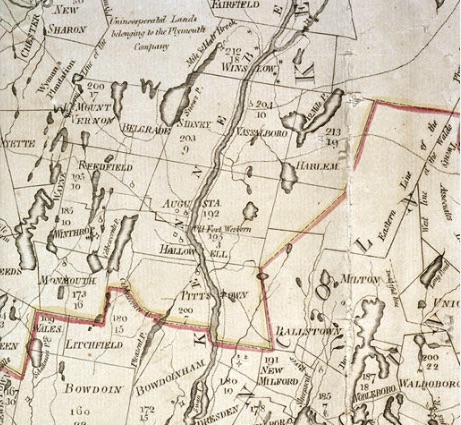Up and Down the Kennebec Valley: Early surveyors – John Jones

Map of central Maine 1799. Note Harlem (before it was China) at right; Winslow on both sides of the Kennebec River; Vassalboro and Sidney on either side of the river; Fairfield at the top.
by Mary Grow
Yet one more important early surveyor in the central Kennebec Valley was John Jones (c. 1743 – Aug. 16, 1823), known as “Black” Jones because of his dark complexion, and later because of his unpopular politics.
Capt. Charles E. Nash, author of the Augusta chapters in Henry Kingsbury’s Kennebec County history, and others said Jones was short and compactly built. Nash added “lithe of limb, flippant of speech.”
Nash claimed that, “This [Kingsbury’s] history will mention no personage with a career more unique and replete with sensation and romance than that of ‘Black’ Jones, the incorrigible and dauntless tory of Fort Western in primitive Augusta.”
An on-line source says Jones lived in Concord, Massachusetts, as a young man. The Plymouth/Kennebec Company/Proprietors apparently helped him learn the surveyor’s trade and sent him to the Kennebec Valley, specifically Hallowell, early in 1771, when he was 28 years old.
Judging by the number of times his name appears in local histories just in the central Kennebec Valley, Jones lotted out large areas for his employers.
His first survey, James North said in his Augusta history, was of “a part of Pondtown and Hallowell”; the resulting plan was dated April 7, 1771. (Wikipedia’s history of Winthrop, Maine [west of Manchester, which is west of Hallowell], says Winthrop was named Pondtown “for its lakes and ponds” before being incorporated as Winthrop on April 26, 1771.)
In 1772, North said, Jones surveyed lots east of the Sheepscot River (in and around the area that is now Montville) and drew up a plan. In 1773, he did the same in Canaan, north of present-day Clinton.
Jones started work in 1774 in Vassalboro and Sidney, North wrote, moving to Unity and China. (See the July 10 history article for Nathan Winslow’s 1771 surveys of Vassalboro and Sidney.)
Alma Pierce Robbins said, in her Vassalboro history, that Jones laid out two more tiers of lots east of the three tiers Winslow mapped in 1771, with a “gore” – an irregular north-south strip – between the third and fourth tiers. This addition brought Vassalboro approximately to its present eastern boundary with China, encompassing the outlet of China Lake (then Twelve Mile Pond).
In Sidney, according to Alice Hammond’s history, Jones did the same thing. Winslow had surveyed the first three miles into Sidney from the Kennebec River, and Jones did the next two miles, extending the surveyed area to Messalonskee Lake.
Here, too, there was a gore between the two sets of lots, Hammond said. She explained it as “caused by the curve of the earth and the fact that the land could not be measured in even miles in depth.”
According to the China bicentennial history, the Kennebec Proprietors hired Jones and Abraham Burrell (or Burrill) in the fall of 1773 to survey about 32,000 acres inland from Vassalboro, around what became China Lake. The men began work that fall and resumed in the spring of 1774.
Jones spent the winter in Gardiner, where he met some of the Clark family, from Nantucket, who came back with him in March 1774 and became China’s first settlers. Burrell also settled near the lake in 1774 or 1775.
Nash wrote that in 1773, Jones built a sawmill on the west bank of the Kennebec, in the northern part of Hallowell. He described the site: “at the lower fall of the then wild and picturesque little river that has since been metamorphosed into the now shrunken and jaded stream called Bond’s brook (from Thomas Bond – died 1815 – who built the large brick house at the foot of Gas-house hill – the first brick house in Augusta).”
Jones’ mill saved builders on the west bank the need to cross the river to get lumber, Nash observed.
When the American Revolution began, Jones openly sided with the British. Nash called him “saucy, active, and exasperating.” At first he was not unpopular, and used his influence “to disturb town meetings and bother the popular party generally.”
As the revolutionary movement gained, Jones fell out of favor, until a Hallowell town meeting declared him a traitor – no date given. North said he escaped conviction because the law under which he was tried expired; Nash said Jones went to Boston, where he was jailed (no date nor length of incarceration given).
Laurel Thatcher Ulrich wrote that before Jones left Hallowell, he deeded his mills and other property to his wife’s family. Thus Ephraim Ballard was able to lease them in 1776 or 1777 (see the July 10 article on Ballard).
One of Ulrich’s footnotes quotes information that before his exile, Jones served the Kennebec Proprietors by “certifying land petitions from prospective settlers” between 1773 and June 1776, suggesting he left town that month.
Ulrich said Jones owned two different parcels, a “landing” on the east side of the Kennebec in Hallowell and mills on Bowman’s Brook (later Bond or Bond’s Brook), on the west shore and farther north, in what became Augusta in 1797.
When Martha Ballard started her diary in August 1787, she, Ephraim and five children were living in Jones’ Bowman’s Brook house. She described it as having two rooms downstairs, “east” and “west,” and above two unfinished rooms “unusable in winter.” The property included a cellar, barn and gardens.
Jones escaped from Boston, and on Aug. 29, 1779, made it to Québec, where he enlisted in the British Army with the rank of captain. From a British base at Castine, he made enough successful raids against Revolutionary forces to make himself “very obnoxious” (North’s phrase) to his former neighbors.
One instance, mentioned in more than one history, involved a night raid on Pownalborough. Jones captured General Charles Cushing, barefoot and in his nightclothes, and delivered him to the British at Castine – “marched him through the wilderness,” Nash wrote. (Pownalborough and Castine are about 90 miles apart, by contemporary reckoning.)
An on-line source says Jones helped the British establish a safe haven for Loyalists on the Penobscot River, presumably using his surveying skills. After the 1783 peace treaty established the St. Croix River as the boundary between the new United States and Nova Scotia, he surveyed what became the town of St. Andrews, New Brunswick, on the tip of the Canadian peninsula across the bay from Robbinston, Maine.
From the summer of 1783 into 1785, Jones worked “virtually single-handed” in New Brunswick, in what the on-line source described as a fairly hostile environment. Settlers were pressing for lots to be assigned in a hurry, and an American, Colonel John Allan, tried to block his work.
Allan, “the American superintendent of eastern Indians,” argued that Jones was surveying the wrong river and was really on United States land. In the fall of 1783, he arrested Jones, but the surveyor escaped (again).
The on-line source says Jones “acquired” property in and near St. Andrews, including a mill privilege (no information that he developed it), and on Grand Manan Island (off the coast from Lubec, Maine, on the Canadian side of the international boundary).
Martha Ballard wrote that on April 12, 1791, the Ballards turned over the Jones house to Peter Jones, John’s brother, and moved to the Howard farm a short distance south.
Ballard recorded John Jones as visiting at her house on Nov. 8 and Nov. 11, 1792. She gave no explanation, though she mentioned he collected some money that Ephraim Ballard owned him.
Jones returned to the Kennebec Valley for good, “perhaps as early as 1793, when he compiled a map for the Plymouth Company,” the on-line source says. Nash wrote that apparently he and his former townspeople became “tolerably reconciled.”
North wrote that Jones moved back to Hallowell (giving no date); Nash said he came back to what became Augusta in February 1797. Both said that he built a house where he lived the rest of his life. Nash located it on the north bank of Bond Brook, between his mill and the Kennebec (which would have been in Augusta after 1797).
Jones married Ruth Lee, “originally of Concord” (according to the on-line source) and sister of “Judge Lee of Wiscasset” (according to North). Neither writer dated the marriage, though it must have been before the mid-1770s. When his wife left Maine no one mentioned; North said she was with him in St. Andrews in April 1784. Both historians said the couple had no children.
North described Mrs. Jones as “tall, of good appearance, well educated for the times, and…much esteemed by her intimate friends.” Many of them wondered “how she could marry Black Jones.”
In later years, North wrote, Mrs. Jones became secretive about her age. When her friend, Judge Daniel Cony, tried to surprise her into a revelation with an unexpected direct question, “She drew up her tall form with an air of offended dignity, raised her half-closed hand towards the Judge, extending her little finger, and replied quickly, ‘Just as old, Judge Cony, as my little finger.'”
John Jones died Aug. 16, 1823, at the age of 80. Ruth Jones died Oct. 7, 1835, North said. He guessed her age then at about 90, though it was reported in the Kennebec Journal as 84.
Nash wrote that both were buried in what he called in 1892 “unmarked and forgotten graves in Mt. Vernon Cemetery.” Find a Grave currently lists seven Joneses in this cemetery, including Peter (perhaps John’s brother?), who died March 9, 1796, but no John or Ruth.
Main sources:
Kingsbury, Henry D., ed., Illustrated History of Kennebec County Maine 1625-1892 (1892)
North, James W., The History of Augusta (1870)
Ulrich, Laurel Thatcher, A Midwife’s Tale The Life of Martha Ballard, Based on Her Diary, 1785-1812 1990
Websites, miscellaneous.
Responsible journalism is hard work!
It is also expensive!
If you enjoy reading The Town Line and the good news we bring you each week, would you consider a donation to help us continue the work we’re doing?
The Town Line is a 501(c)(3) nonprofit private foundation, and all donations are tax deductible under the Internal Revenue Service code.
To help, please visit our online donation page or mail a check payable to The Town Line, PO Box 89, South China, ME 04358. Your contribution is appreciated!




Leave a Reply
Want to join the discussion?Feel free to contribute!